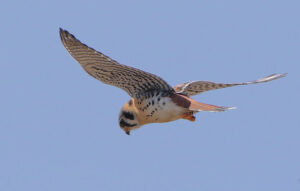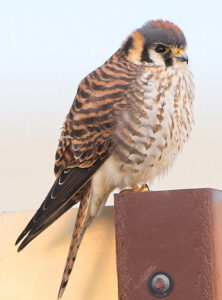American Kestrel, Falco sparverius
Bill Rowe
This week we introduce the falcons, a distinctive world-wide group whose relationships to other birds have been in flux for decades. Recently, DNA analysis has finally produced a firm conclusion: that falcons are not just a separate family but a separate order, far apart from other raptors—in fact, their closest relatives are the parrots! As a group, they are the swiftest and most streamlined of all birds of prey, giving them an aura of power, elegance, and nobility that lies behind the sport of falconry. The little American Kestrel, our most familiar falcon, shares these qualities, but at a level that to us may seem tamer, since its prey is mostly airborne insects and small mammals in the grass; so, while it does occasionally make a dash after something, it is more likely to hover for a while over one spot and then drop. Kestrels can also seem tamer through their willingness to accept a manmade nest box in place of a natural cavity; nest boxes help them maintain their numbers, which have declined in some areas. “American” is an especially apt name for this bird, for it is found all the way from Alaska to the southern tip of Argentina, and from coast to coast. Various other kestrel species live in the Old World, notably the Eurasian Kestrel that is common in the English and European countryside; it may surprise an American visitor by its notably larger size, but in habits it is similar. One note on the name: In bird books that date back to the 1950’s and earlier, you’ll see our bird called the “sparrow hawk”; the change to “kestrel,” like the changes in some other raptors’ names, came in the 1960’s.
IDENTIFICATION: Kestrels have the long, pointed wings and sleek flight silhouette of a falcon, but they are small. The male is brightly colored in blue-gray and orange-rust, while the female (discernibly larger than the male, as in many raptors) is rusty all over on the back, wings, and tail, and barred with black. Both sexes have the unique face pattern of two black vertical stripes. The only other raptor that resembles a kestrel is another falcon, the slightly larger and much less common Merlin, which is always streaked below and either all-brown or all-gray above, never rusty. A Sharp-shinned Hawk may be as small as a Kestrel, but it has the different shape (more rounded wings) and behavior (alternating rapid flaps and a sail) of the accipiter clan.
ST. LOUIS STATUS: Fairly common year-round, but more numerous in migration and winter as extra kestrels arrive from farther north. Typical habitat is open or semi-open countryside and parkland, but they may be seen even in urban and suburban areas, patrolling vacant lots or highway median strips. Watch for their chunky, big-headed outline as they perch on power lines.
Learn more and listen to the calls of American Kestrels here.
Female
Photo Credit: Al Smith
space

Male hovering,
with pointed wings and long tail
Photo Credit: Al Smith





